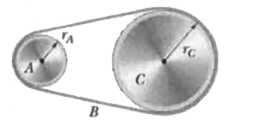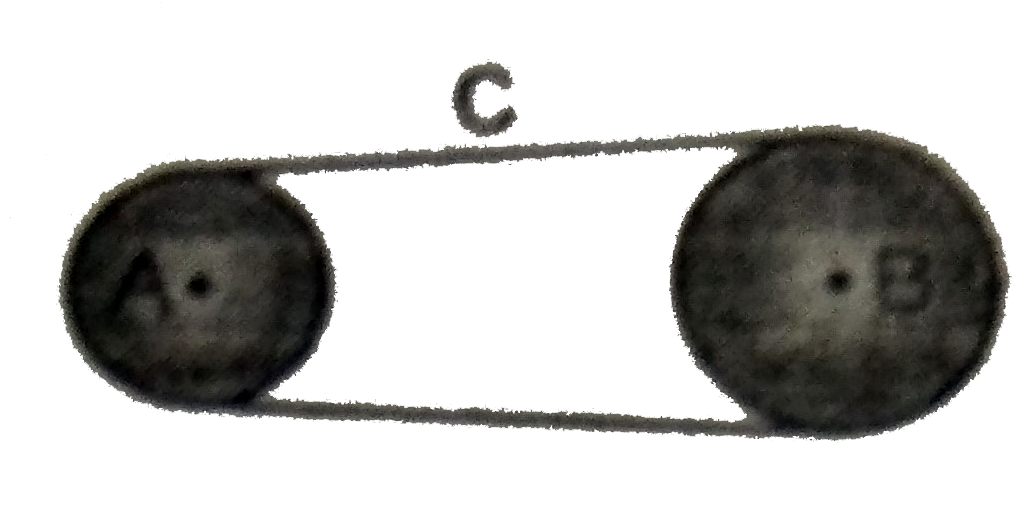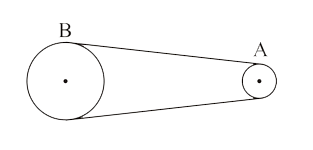A wheel having radius 10cm is coupled by a belt to another wheel of radius 30cm. 1st wheel increases its angular speed from rest at a uniform rate of 1.57rad/s2. The time for 2nd wheel to reach a rotational speed of 100rev/min is …(assume that the belt does not slip)
As the belt does not slip vA=vC
i.e., rAωA=rCωC [as v=rω]
Here, rA=10cm,rC−=30cm
and ωC=(2π×100/60) rad/s
So, 10ωA=30×2π×10060
i.e., ωA=10π rad/s
Now, from 1st equation of rotational motion, i.e.,
ω=ω0+αt
t=ωα
i.e., t=10×π1.57=20 sec.
Topper's Solved these Questions
Similar Questions
In Fig. 10-54, wheel A of radius rA=10cm is coupled by belt B to wheel C of radius rC=25cm. The angular speed of wheel A is increased from rest at a constant rate of 2.0rad/s2. Find the time needed for wheel C to reach an angular speed of 100 rev/min, assuming the belt does not slip.

View SolutionWheel A of radius rA=10cm is coupled by a belt C to another wheel of radius rB=25cm as in the figure. The wheels are free to rotate and the belt does not slip . At time t=0 wheel A increases it's angular speed from rest at a uniform rate π/2rad/sec2 Find the time in which wheel B attains a speed of 100r±[ Hint :vA=vB]

View Solution
Knowledge Check
A wheel having radius 10 cm is coupled by a belt to another wheel of radius 30 cm . 1st wheel increases its angular speed from rest at a uniform rate of 1.5rads−2 . The time for 2nd wheel to reach a rotational speed of 100rev/min is ... (assume that the belt does not slip )
A20 secB10 secC1.5 secD15secIn figure whell A of radius rA=10cm is coupled by belt B to whell C of radius rC=25cm. The angular speed of whell A is increased from rest at a constant rate of 1.6rad/s2. Find the time needed for whell C to reach an angular speed of 12.8rad/s, assuming the belt does not slip.
 .A15 sB12.5 sC20 sD10 s
.A15 sB12.5 sC20 sD10 sA wheel increases its speed from 60 rpm to 120 rpm in 10 s. Number of rotation made by it in 10 s is
A10B15C25D20
Two wheels having radii in the ratio 1:3 are connected by a common belt. If the smaller wheel is accelerated from rest at a rate 1.5rads2 for 10 s, find the angular velocity of bigger wheel
View SolutionA wheel starting from rest,rotates with a uniform angular acceleration of 2rads2 .Then the number of rotations it performs in tenth second is
View SolutionThe radius of a wheel of car is 0.4m. The car is accelerated from rest by an angular acceleration of 1.5rad/s2 for 20s. How much distance will the wheel cover in this time and what will be its linear velaocity ?
View SolutionA circular wheel of 0.50 m radius is moving with a speed of 10ms−1. Find the angular speed.
View SolutionA wheel of radius 0.1 m (wheel A) is attached by a non-stretching belt to a wheel of radius 0.2 m (wheel B). The belt does not slip. By the time wheel B turn through 1 revolution, wheel A will rotate through:

View Solution